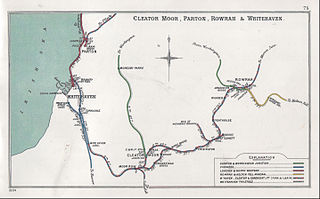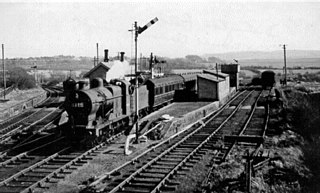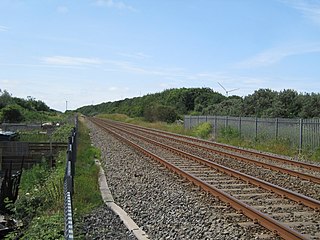
Corkickle railway station is a railway station serving the suburb of Corkickle near Whitehaven in Cumbria, England. It is on the Cumbrian Coast Line, which runs between Carlisle and Barrow-in-Furness. It is owned by Network Rail and managed by Northern Trains. The station opened on 3 December 1855, and is at the southern end of the 1,219 m (3,999 ft) tunnel from Whitehaven. Between 1855 and 1957, the station was known as Whitehaven Corkickle.

Cleator Moor is a town and civil parish in Cumbria, England, within the historic county of Cumberland. It had a population of 6,936 at the 2011 census.

Workington Central railway station was opened by the Cleator and Workington Junction Railway (C&WJR) in 1879 to serve the town of Workington in Cumberland, England. It was situated almost half a mile nearer the town centre than its rival Workington station.
The Whitehaven, Cleator and Egremont Railway was an English railway company which built and operated a standard gauge railway in Cumberland, England intended to open up the hematite orefield to the south-east of Whitehaven. It opened for goods traffic in 1855 and for passenger traffic in 1857.

Rowrah is a village in Cumbria, England, and spans the civil parishes of Arlecdon and Frizington and Lamplugh. The majority of Rowrah is within Arlecdon and Frizington. The parish boundaries are formed from the Windergill Beck and Colliergate Beck: as such nine properties, Rowrah Hall Farm, Rowrah Hall, Ainsdale House, Rowrah Head, four properties on Pheasants Rise and Rowrah Station technically fall within Lamplugh.

Moor Row railway station was built by the Whitehaven, Cleator and Egremont Railway. It served the village of Moor Row, Cumbria, England.

Beckermet railway station is a disused rail station located in the village of Beckermet in Cumbria.
Woodend railway station was planned by the Whitehaven, Cleator and Egremont Railway on its Sellafield to Moor Row branch, but by the time the station opened the company had been bought out by the LNWR and Furness Railway who operated the line jointly until grouping in 1923.

Cleator Moor West railway station was opened as "Cleator Moor" by the Cleator and Workington Junction Railway (C&WJR) in 1879. It served the growing industrial town of Cleator Moor, Cumbria, England.

High Harrington railway station was opened by the Cleator and Workington Junction Railway (C&WJR) in 1879. It was situated half a mile south of Harrington Junction on the company's main line. and served what was then the eastern extremity of Harrington in Cumbria, England. The station is not to be confused with the current Harrington station a kilometre away on the coastal line.

Yeathouse railway station was a later addition to the Whitehaven, Cleator and Egremont Railway. It served the communities of Yeathouse and Eskett, near Frizington, Cumbria, England.

Frizington railway station was built by the Whitehaven, Cleator and Egremont Railway. It served the industrial Parkside area of Frizington, Cumbria, England.
Egremont railway station was built by the Whitehaven, Cleator and Egremont Railway as the first southern terminus of what would become the Moor Row to Sellafield branch. In 1878 the company was bought out by the LNWR and Furness Railway who operated the line jointly until grouping in 1923.
St Thomas Cross Platform was a railway station used by workmen's trains on the Moor Row to Sellafield line on what is now the southeastern, Cringlethwaite, edge of Egremont, Cumbria, England.
Beckermet Mines railway station was situated at Pit No.1 of the mine of the same name. It was used by workmen's trains which travelled along a branch which curved eastwards off the Moor Row to Sellafield line, primarily to handle the iron ore lifted at the site.
Moresby Junction Halt railway station was opened by the Cleator and Workington Junction Railway (C&WJR) in 1910. Very few people lived near the halt, which served nearby Walkmill Colliery and coke ovens in Cumbria, England.
Keekle Colliers' Platform railway station was opened by the Cleator and Workington Junction Railway (C&WJR) in July 1910, closed the following January, reopened in June 1913 then closed for good on 1 October 1923. The halt was provided to enable residents of the isolated Keekle Terrace, less than 100 yds from the track, to get to and from work at the equally isolated Walkmill Colliery and coke ovens in Cumbria, England. The Platform is not shown by Jowett.

Moresby Parks railway station was opened by the Cleator and Workington Junction Railway (C&WJR) in 1879. It was situated just north of the summit of the company's main line and served the scattered community of Moresby Parks in Cumbria, England.

Distington railway station was opened jointly by the Cleator and Workington Junction Railway (C&WJR) and the LNWR and Furness Joint Railway on 1 October 1879. It was situated on the northern edge of the village of Distington, Cumbria, England, where the C&WJR's north–south main line crossed the Joint Line's east–west Gilgarran Branch.

Siddick Junction railway station was opened by the Cleator and Workington Junction (C&WJR) and London and North Western Railways in 1880 to provide exchange platforms for passengers wishing to change trains from one company's line to the other. A passenger travelling from Maryport to Distington, for example, would change at Siddick Junction. As a purely exchange station - like Dovey Junction and Dukeries Junction elsewhere in the country - the owning companies would not need to provide road or footpath access or ticketing facilities as no passengers were invited to enter or leave the station except by train.













